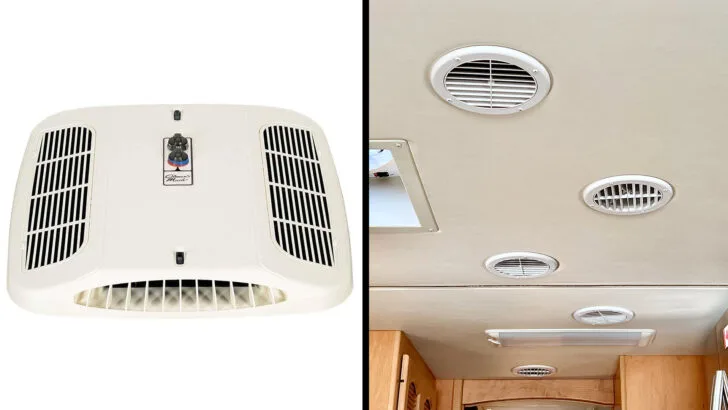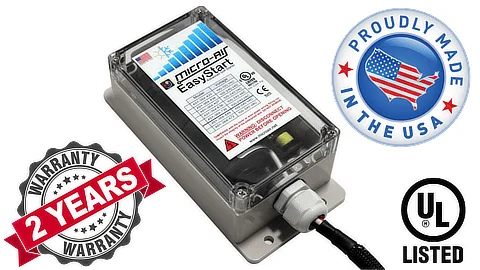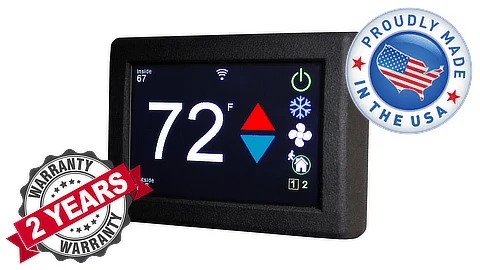When you’re shopping for a new (or new-to-you) RV, there are many features and amenities to consider and prioritize. One that’s often overlooked is the choice between ducted vs non-ducted RV AC.
RV air conditioning is a pretty important feature for traveling and camping comfortably. Most of us spend a fair amount of time traveling where the weather is warm and sunny. In fact, many RVers travel only in summer. But of course, that’s when it can get the hottest, potentially turning an RV into a sauna.
We’ve posted about air conditioning systems before, including our own dual A/C units with heat pumps. We even installed a Micro-Air EasyStart in each one, which is a fantastic device that reduces AC start-up current by 65% to 75%. This allows two A/C units to run off a 30-amp connection or even a single air conditioner off a small portable generator.
We’ve also posted about specific RV AC units like the Truma Aventa, and 12-volt RV air conditioners that both cool and blow the air using 12V power.
Today we’re looking at another variable to consider in RV cooling systems: Ducted vs non-ducted air conditioning systems.
So, let’s take a look at the difference between ducted and ductless AC systems. Is one preferable to the other? And what factors determine which type of air conditioning system you can have?
What’s the Difference Between Ducted and Non-Ducted RV AC?
Essentially, the difference between a non-ducted vs a ducted RV air conditioner is where the cold air blows into the RV.
Non-Ducted RV AC
A non-ducted AC unit simply blows cold air out of the ceiling directly under the AC unit. Most of us have seen those gratings in the ceiling, often referred to as a “Chill Grill.”
Cold air is blown into the interior of the RV from a large lower vent located directly beneath the air conditioning unit. The return air (warm air) is drawn in from the same area.
With non-ducted RV AC systems, cool air is distributed from this one location in the RV. Think “window air conditioner” in a sticks & bricks house.
Non-ducted AC is the most common type of air conditioning system found in RVs.
Ducted RV AC
Ducted RV AC is considered a higher-end AC system because it allows for the distribution of cool air throughout the entire RV through vents that are located throughout the rig. It’s more like central air conditioning in a traditional home.
This type of RV AC system is more common on Class A motorhomes and high-end fifth wheels.
So, with non-ducted AC systems, the cool air comes into the RV from a single large outlet right below the air conditioner. But with a ducted RV AC system, the cooled air (and warm air if it’s also a heat pump) is blown into ducts that run throughout the RV. This distributes the air more evenly and completely, making it particularly desirable for larger rigs.
Note that a system can be fully ducted (output and return air are both ducted) or partially ducted (only the outlet air is ducted, but the return air is drawn in through the vent/grill directly beneath the AC unit).

On the left is a typical non-ducted RV AC “chill grill” with air flowing into the rig directly below the rooftop A/C unit. On the right are a few of the many round vents in the ceiling of our own rig with ducted A/C.
What Are the Pros and Cons of Ducted vs Non-Ducted RV AC?
There are a few pros and cons of both ducted and non-ducted RV AC systems.
Advantages of Non-Ducted RV AV Systems
- Cheaper to install.
- Little-to-no restriction on the airflow.
Disadvantages of Ducted RV AV Systems
- Typically louder/noisier than ducted systems.
- Hot & cold spots can form due to how the cold air is distributed (or isn’t distributed).
Advantages of Ducted RV AV Systems
- Generally quieter operation.
- Better distribution of the air helps reduce hot and cold spots for more even, comfortable temperatures throughout the RV.
Disadvantages of Ducted RV AV Systems
- More complex, and therefore more expensive.
- Airflow can be reduced due to increased restrictions imposed by ducting (although generally offset by the improved air distribution through the ducts).
The Bottom Line on Ducted vs Non-Ducted RV AC
While ducted AC systems generally provide improved and quieter overall cooling to the entirety of an RV’s interior, they’re usually reserved for larger rigs.
Smaller RVs don’t typically come with ducted AC systems because:
- Less space in smaller rigs means leaving out some items, such as ductwork.
- Smaller RVs don’t require ducting for adequate cooling.
- Ducted systems cost more, so keeping prices down on smaller rigs dictates many manufacturers’ choices.
If you have a large, long RV, as we do, you want cool air (and warm air in the case of heat pumps) distributed evenly all the way from the front of your rig to the rear.
That would be harder to achieve with a non-ducted system blowing cool or warm air out of a grill beneath a single AC unit or heat pump. Or even two chill grills.
So, depending on the size of your RV (or the one you’re looking to buy), the issue of ducted vs non-ducted RV AC may not even be a consideration. (For example, you wouldn’t need a ducted system in a Class B RV… and it wouldn’t come with it anyway.)
But if you’re in the market for a larger rig, consider the pros and cons of ducted vs non-ducted RV AC systems, and see where the balance falls for you!
If you’d like to run one RV A/C unit from a small portable generator, or if you’ve got a 50-amp rig and want to be able to run both of your A/C units at a 30-amp hook-up, consider installing a MicroAir EasyStart on each A/C unit.
We’ve used them ourselves for several years, and they work amazingly well.
For handy RVers, it’s a DIY install. Just follow our video tutorial. We’ve also included a coupon below the video to save you some cash!
Run your A/C from a small, portable generator OR run two A/C units on a 30-amp connection. By reducing the start-up current needed to get your A/C compressor running, the EasyStart 364 keeps you...Show More
Run your A/C from a small, portable generator OR run two A/C units on a 30-amp connection. By reducing the start-up current needed to get your A/C compressor running, the EasyStart 364 keeps you cool!
Watch our EasyStart installation video
Get $25 off each Micro-Air EasyStart 364 you buy factory direct using the code listed here.
Show LessWhile you’re at it, you might want to be able to control your RV’s ventilation system from anywhere in the world (including from under the covers), like we do!
Looking to add some "smart home" features to your RV? How about a new color touchscreen, programmable thermostat? Even better, how about one that allows you to control it (even remotely) using a...Show More
Looking to add some "smart home" features to your RV? How about a new color touchscreen, programmable thermostat? Even better, how about one that allows you to control it (even remotely) using a smartphone or tablet? That's what the Micro-Air Easy Touch RV thermostat does.
Save $15 on each EasyTouch RV Thermostat when you buy direct from Micro-Air.
Show LessFree RVing Tips, Tricks, Reviews, Giveaways & More
Subscribe to our daily newsletter! We’ve been full-time RVers for 20 years (!) and share everything we’ve learned about RVing in our daily blog posts. Join our online community to receive a wealth of great RVing knowledge delivered right to your inbox.
Whether this is your first time on the road or you’re a seasoned full-timer, you’ll love the wide range of RVing topics we cover. Don’t miss a single article or any of our famous RV gear Giveaways — Subscribe today!




Larry
Friday 22nd of December 2023
Went thru 2 travel other branded trailers before finding our 25’ Airstream with ducted heat and AC. We can FINALLY hear the TV and music and play cards or board games, even sleep, without the incessant drone high decimal level of un-ducted.
Jamie
Friday 23rd of December 2022
One other disadvantage of a ducted system is when the cold air is going through the ducts in the attic it is being warmed making it less efficient. Often ducted systems can’t keep up with really hot days like a non ducted system.
Virginia
Sunday 24th of December 2023
@Jamie, I was wondering abut this very situation. Our 5th wheel has no shade. Southeastern Ontario. Summer of 2023 was a real stinker and we found we had to use fans in addition to the ducted air con. Next year, I will try to get the cool air to just flow through directly from the vent located beside the filter grill (ceiling air con). Wondering if there's a way to block off the other ducts running through ceiling or an actual switch? I'll take a look. Thanks.